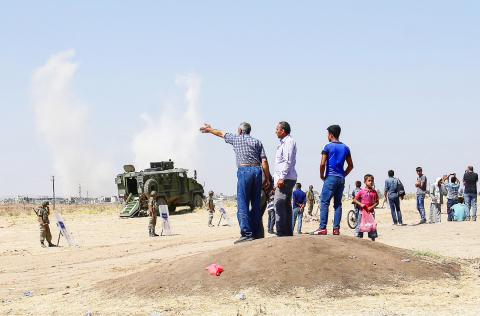Islamic State fighters who launched a surprise attack on a Syrian border town massacred more than 200 civilians, including women and children, before they were killed or driven out by Kurdish forces, reports said on Saturday.
Kurdish activist Mustafa Bali, the Britain-based Syrian Observatory for Human Rights and Kurdish official Idris Naasan put at 40 to 50 the number of Islamic State fighters killed in the two days of fighting since the militants sneaked into the town of Kobane before dawn on Thursday.
Clashes continued to the south and west of the predominantly Kurdish town on the Turkish border on Saturday, although the fighting in the south quietened by nightfall, they said.

Photo: AP
Naasan said 23 of the city’s Kurdish defenders were killed in the fighting, but the Syrian Observatory put the number at 16. The discrepancy could not immediately be reconciled, but conflicting casualty figures are common in the aftermath of major fighting.
“Kobane has been completely cleared of DAESH, and Kurdish forces are now combing the town looking for fighters who may have gone into hiding,” Bali, using the Arabic acronym for the Islamic State group, told reporters by telephone from Kobane.
Syria’s SANA news agency also reported that Kobane had been cleared of Islamic State fighters.
The more than 200 civilians killed in the past two days included some who perished in suicide bombings, including one at the border crossing with Turkey, but they were mostly shot in cold blood, some in their own homes, the activists said.
“They were revenge killings,” observatory director Rami Abdurrahman told reporters.
Others were caught in the crossfire as gun battles raged in the town’s streets or were randomly targeted by Islamic State snipers on rooftops, he said.
Bali, Abdurrahman and Naasan all said the number of Kobane civilians and Islamic State fighters found dead was likely to rise as rescue teams continue to search neighborhoods where the fighting took place.
Targeting civilians is not an uncommon practice by the Islamic State group, whose men have killed thousands in Syria and Iraq over the past year, when the group formerly known as the Islamic State of Iraq and the Levant blitzed through large swathes of territory and declared a caliphate that spans both nations.
The group often posts on social media gruesome images of its fighters executing captives as part of psychological warfare tactics to intimidate and inspire desertions among their enemies. Last week, it posted one of its most gruesome video clips, showing the execution of 16 men it claimed were spies. Five of the men were drowned in a cage, four were burned inside a car and seven were blown up by explosives.
The killing of so many civilians in Kobane was premeditated and meant by the Islamic State to avenge their recent defeats at the hands of Kurdish forces, Abdurrahman said.
The Western-backed Kurdish forces have emerged as a formidable foe of the extremist group, rolling them back in the north and northeast parts of Syria, where the Kurds are the dominant community, as well as in northern Iraq, where they have also made significant gains against the Islamic State.
Kobane has become a symbol of Kurdish resistance after it endured a months-long siege by the Islamic State group before Kurdish forces, backed by US-led coalition airstrikes, broke through and drove the militants out in January.

Nvidia Corp yesterday unveiled its new high-speed interconnect technology, NVLink Fusion, with Taiwanese application-specific IC (ASIC) designers Alchip Technologies Ltd (世芯) and MediaTek Inc (聯發科) among the first to adopt the technology to help build semi-custom artificial intelligence (AI) infrastructure for hyperscalers. Nvidia has opened its technology to outside users, as hyperscalers and cloud service providers are building their own cost-effective AI chips, or accelerators, used in AI servers by leveraging ASIC firms’ designing capabilities to reduce their dependence on Nvidia. Previously, NVLink technology was only available for Nvidia’s own AI platform. “NVLink Fusion opens Nvidia’s AI platform and rich ecosystem for

‘WORLD’S LOSS’: Taiwan’s exclusion robs the world of the benefits it could get from one of the foremost practitioners of disease prevention and public health, Minister Chiu said Taiwan should be allowed to join the World Health Assembly (WHA) as an irreplaceable contributor to global health and disease prevention efforts, Minister of Foreign Affairs Lin Chia-lung (林佳龍) said yesterday. He made the comment at a news conference in Taipei, hours before a Taiwanese delegation was to depart for Geneva, Switzerland, seeking to meet with foreign representatives for a bilateral meeting on the sidelines of the WHA, the WHO’s annual decisionmaking meeting, which would be held from Monday next week to May 27. As of yesterday, Taiwan had yet to receive an invitation. Taiwan has much to offer to the international community’s

CAUSE AND EFFECT: China’s policies prompted the US to increase its presence in the Indo-Pacific, and Beijing should consider if this outcome is in its best interests, Lai said China has been escalating its military and political pressure on Taiwan for many years, but should reflect on this strategy and think about what is really in its best interest, President William Lai (賴清德) said. Lai made the remark in a YouTube interview with Mindi World News that was broadcast on Saturday, ahead of the first anniversary of his presidential inauguration tomorrow. The US has clearly stated that China is its biggest challenge and threat, with US President Donald Trump and US Secretary of Defense Pete Hegseth repeatedly saying that the US should increase its forces in the Indo-Pacific region

ALL TOGETHER: Only by including Taiwan can the WHA fully exemplify its commitment to ‘One World for Health,’ the representative offices of eight nations in Taiwan said The representative offices in Taiwan of eight nations yesterday issued a joint statement reiterating their support for Taiwan’s meaningful engagement with the WHO and for Taipei’s participation as an observer at the World Health Assembly (WHA). The joint statement came as Taiwan has not received an invitation to this year’s WHA, which started yesterday and runs until Tuesday next week. This year’s meeting of the decisionmaking body of the WHO in Geneva, Switzerland, would be the ninth consecutive year Taiwan has been excluded. The eight offices, which reaffirmed their support for Taiwan, are the British Office Taipei, the Australian Office Taipei, the